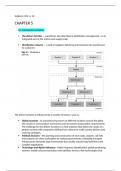Endterm: Ch5, 6, 10
CHAPTER 5
5.1 Introduction to Deliver
The deliver function — sometimes also described as distribution management—is an
integrated part of the end-to-end supply chain.
Distribution network — a web of suppliers delivering into factories into warehouses
to customers
The deliver function is influenced by a number of factors, such as:
Global economy - As manufacturing moves to different locations around the globe,
this results in more product movements and increased transportation requirements.
The challenge for the deliver function is to find solutions that follow the needs of a
global economy with companies shifting from national to multi-country delivery and
sourcing strategies.
Political decisions - The planning and construction of new roads, airports, rail links
and seaports are often undertaken by national governments. Extending transport
infrastructure demands large investments that usually require long lead-times and
complex negotiations.
Technology and digital influences - Radio frequency identification, global positioning
systems, mobile telecommunication and satellites are but a few technologies that
, have already revolutionised transportation and warehousing. In the future, one can
expect technology playing an even greater role in the digital era.
Environmental considerations - This has led to a number of environmentally friendly
innovations in the transport industry. Smooth paint, for example, reduces the water
resistance of container vessels, which in turn reduces CO2 emission in sea transport.
5.1.1 Network Trade-Offs
As the number of warehouses increases, the associated deliver cost also increases because
of three cost components (Chopra and Meindl 2010):
1. Facility costs - pay the warehouse running cost, such as insurance, labour and
electricity, for each of the facilities
2. Inventory costs - carrying additional amounts of safety stock.
3. Primary transport costs - As we add warehouses to the network, primary transport
costs initially decrease because the transport distance gets shorter. If we keep adding
distribution facilities to the network, the delivery quantity per warehouse becomes
smaller and smaller, until trucks travel half empty. This is the point where the primary
transport costs curve goes up in the hockey blade; transport costs increase again.
5.1.2 Facility Location Decisions
In order to work out the optimum number of facilities, companies use one of a number of
the major network modelling programmes. These complex software optimisation tools work
with the Centre of Gravity (COG) principles (McKinnon et al. 2002). With the COG method,
you can locate facilities by using a weighting of customer demand data on a grid map.
Mathematically, this method gives you the optimum location of your warehouse or
distribution centre.
However, before the final network optimisation decision is made, other non-mathematical
factors need to be considered, such as:
, Cost of commercial property in that location
Availability of skilled labour
Time to build or occupy the site
Accessibility of government grant or subsidy
Proximity of road, rail, water and air networks
Customer service implications
Environmental considerations
5.1.3 Deliver Components
There are three main components of deliver within supply chain management:
1. Transport management: moving products in trucks, ships, planes, pipes and trains
2. Warehouse management: keeping and moving stock within depots, warehouses and
distribution centres
3. Order management: capturing the customer order all the way through to bringing
back a proof of delivery in order to raise a customer invoice
5.1.4 Transport Management
Variables in transport management include:
1. Speed
2. Reliability
3. Security
4. Quality
5. Environment
6. Cost





